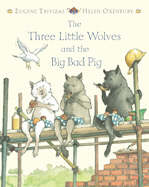Resources
This item is one of over 25,000 physical resources available from the Resources Collection. The Archive Collection covers over 50 years of curriculum development in the STEM subjects. The Contemporary Collection includes all the latest publications from UK educational publishers.
This item is one of over 25,000 physical resources available from the Resources Collection. The Archive Collection covers over 50 years of curriculum development in the STEM subjects. The Contemporary Collection includes the latest publications from UK educational publishers.
Three little pigs and the recycled houses
Using the context of the well known story of the Three Little Pigs, pupils are introduced to the concept of the materials life cycle. A presentation aids learning about different building materials and how waste is created but can also be reduced. In the activity, pupils are invited to design recycled house ideas...

The classic fight between pigs and wolves as you've never seen it. The three little wolves erect first a solid brick house. The big bad pig comes along and when huffing and puffing fails to work, he uses a...
Three of a Kind
In this Bowland assessment task, students are required to use their knowledge of geometry to describe a pattern. They are presented with a pattern consisting of three hexagons made up of triangles and have to what is the same and what is different about each shape. Students are encouraged to consider lengths,...
Three Parents
This Science upd8 resource is set in the context of controversial medical study. Researchers have created a human embryo with three separate parents. The scientists believe the development is a potential breakthrough in the prevention of serious diseases. Students take on the role of a trainee nurse who has to...
Three Parents
A new procedure which creates babies with the DNA of three people has just been given the go ahead in Britain. In this activity, students learn how it can help women with a serious inherited condition to have a healthy baby and why it is deemed so controversial. They describe how to create an embryo with three...
Three triangles and a square
In this presentation and collection of student worksheets a diagram shows a square and three right angled triangles, with each shape sharing a common side. Some of the lengths are given in surd form, from which students have to find the area of the square.
The solution involves the use of Pythagoras’ theorem...

Here is an effective and contemporary approach to conventional one and two-dimensional modes of education. The author has borrowed 'cells' from the...
Sir Christopher Zeeman is without doubt one of the greatest geometers and topologists of his time. The material in this text does not conform to any school curriculum. Rather it is an eclectic mix of topics in three-dimensional geometry which he hopes will prove fascinating and stimulating to abler students in the...
